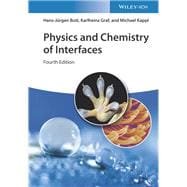Comprehensive textbook on the interdisciplinary field of interface science, fully updated with new content on wetting, spectroscopy, and coatings
Physics and Chemistry of Interfaces provides a comprehensive introduction to the field of surface and interface science, focusing on essential concepts rather than specific details, and on intuitive understanding rather than convoluted math. Numerous high-end applications from surface technology, biotechnology, and microelectronics are included to illustrate and help readers easily comprehend basic concepts.
The new edition contains an increased number of problems with detailed, worked solutions, making it ideal as a self-study resource. In topic coverage, the highly qualified authors take a balanced approach, discussing advanced interface phenomena in detail while remaining comprehensible. Chapter summaries with the most important equations, facts, and phenomena are included to aid the reader in information retention.
A few of the sample topics included in Physics and Chemistry of Interfaces are as follows:
- Liquid surfaces, covering microscopic picture of a liquid surface, surface tension, the equation of Young and Laplace, and curved liquid surfaces
- Thermodynamics of interfaces, covering surface excess, internal energy and Helmholtz energy, equilibrium conditions, and interfacial excess energies
- Charged interfaces and the electric double layer, covering planar surfaces, the Grahame equation, and limitations of the Poisson-Boltzmann theory
- Surface forces, covering Van der Waals forces between molecules, macroscopic calculations, the Derjaguin approximation, and disjoining pressure
Physics and Chemistry of Interfaces is a complete reference on the subject, aimed at advanced students (and their instructors) in physics, material science, chemistry, and engineering. Researchers requiring background knowledge on surface and interface science will also benefit from the accessible yet in-depth coverage of the text.








